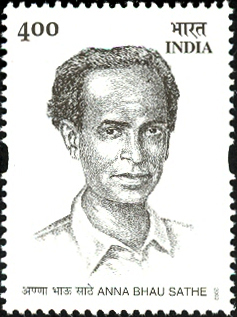Dr Aniruddha Babar
‘Our journey toward justice is relentless, for it is a journey toward a more humane world.’
~ Annabhau Sathe
In the annals of Indian social and political discourse, the names of Annabhau Sathe and Dr. B.R. Ambedkar loom large, casting a profound and lasting influence on the nation’s relentless pursuit of social justice and equality. These two remarkable figures, although distinct in their backgrounds and ideologies, converged in their shared commitment to the empowerment of the marginalized and the eradication of caste-based discrimination. In this philosophical exploration, we embark on a journey through the intellectual landscape of Annabhau Sathe’s thoughts on Dr. B.R. Ambedkar, unraveling the intricate threads that connect their ideals and ideologies in the relentless quest for a just and equitable society. As we navigate the intersection of these two luminaries’ philosophies, we gain insight into the dynamic interplay of ideas, strategies, and visions that have indelibly marked the trajectory of social reform in India.
Annabhau Sathe, a prominent Marathi writer, poet, and social reformer, was deeply influenced by the ideals of Dr. B.R. Ambedkar. Sathe, himself born into the Dalit community, shared Ambedkar’s vision of a casteless society, where the shackles of discrimination and untouchability would be forever shattered. Sathe’s literary works, including his magnum opus “Fakira” and his numerous powadas (Ballads), were infused with the spirit of Ambedkarism, advocating for social equality and the empowerment of the oppressed.
Central to Annabhau Sathe’s philosophical alignment with Dr. Ambedkar was the belief in education as the cornerstone of liberation. Dr. Ambedkar’s emphasis on education as the key to breaking the chains of caste-based discrimination resonated deeply with Sathe. Both recognized that knowledge was the most potent weapon against social inequality. For Sathe, education was not merely a means to secure economic prosperity but a tool to cultivate consciousness and self-respect among the downtrodden.
However, their philosophical paths diverged in the realm of aesthetics and cultural identity. Annabhau Sathe, as a folk artist and cultural activist, was deeply rooted in the folk traditions of Maharashtra, particularly the Powada genre. He celebrated the cultural heritage of the oppressed, believing that it could serve as a source of pride and resistance against oppression. In contrast, Dr. Ambedkar, though acknowledging the importance of cultural expression, was more focused on the annihilation of caste, often critiquing the rituals and practices that perpetuated discrimination.
While both thinkers were committed to social reform, their strategies varied. Dr. B.R. Ambedkar took a more technical, legalistic and political approach, advocating for constitutional safeguards and political representation for Dalits through reserved seats. Annabhau Sathe, on the other hand, used the power of art and literature to awaken the consciousness of the masses. He believed in the transformative potential of culture and saw it as a medium to bridge the gap between different castes.
One key philosophical convergence between Sathe and Ambedkar was their critique of the prevailing Hindu social order. Dr. Ambedkar’s seminal work, “Annihilation of Caste,” challenged the caste system’s inherent injustices and called for its complete dismantling. Sathe, in his own way, echoed this sentiment through his writings and performances, highlighting the absurdity of a society divided by birth.
It is essential to recognize that; while Annabhau Sathe was deeply influenced by Dr. B.R. Ambedkar; he was also a distinct voice in the struggle for social justice. Sathe’s unique blend of art, culture, and activism offered an alternative avenue for Dalit empowerment. His devotion to the cause of equality was expressed through the folk traditions he cherished, breathing life into the spirit of Ambedkarism in the hearts of ordinary people.
The philosophical exploration of Annabhau Sathe’s thoughts on Dr. B.R. Ambedkar reveals a complex interplay of ideas and strategies in the quest for social justice. While both shared a common goal of annihilating caste-based discrimination and upliftment of the marginalized, their approaches were nuanced and multifaceted. Sathe’s fusion of culture and activism, inspired by Ambedkar’s vision, demonstrates the rich tapestry of thought within the larger canvas of social reform in India. Together, their legacies continue to inspire generations in the ongoing struggle for equality and justice.
In the tapestry of Indian history, the threads of Annabhau Sathe and Dr. B.R. Ambedkar will forever remain intertwined, creating a vibrant and enduring pattern of hope and resilience. Their individual journeys, though distinct, converged at the crossroads of humanity’s collective struggle for justice and equality.
As we reflect on the philosophical depths of their thoughts, we are reminded of the profound impact they had on our nation’s conscience. Annabhau Sathe’s heartfelt verses and impassioned performances awakened the spirit of resistance in the hearts of the oppressed, while Dr. Ambedkar’s towering intellect and unwavering commitment to social justice reshaped the very foundations of our democracy.
In their pursuit of a just society, Sathe and Ambedkar forged a legacy that transcends time and circumstance. It is a legacy of unwavering determination, of standing up against the tide of discrimination, and of using every tool at their disposal to break the chains of caste-based oppression.
Their convergence on the importance of education as the key to liberation reminds us that knowledge is a beacon of hope, lighting the way forward even in the darkest of times. Their critique of the deeply entrenched caste system reminds us that injustice cannot be allowed to persist unchallenged.
Annabhau Sathe’s celebration of culture and Dr. Ambedkar’s clarion call for constitutional safeguards are both powerful reminders that the battle for equality is fought on multiple fronts. It is not just about changing laws but also about changing hearts and minds.
In the end, the convergence of Annabhau Sathe and Dr. B.R. Ambedkar’s thoughts remind us that the fight for social justice is not a solitary journey but a collective endeavor that spans generations. Their legacies serve as a poignant reminder that we are all bound by a common thread of humanity, and it is our shared responsibility to weave a tapestry of compassion, equity, and unity for the generations yet to come.
Let us, therefore, honor their memory by working tirelessly to build the India they dreamed of, an India where justice flows like a river, and equality shines like the sun on the horizon. The emotional resonance of their thoughts echoes through time, beckoning us to carry their message of hope and change forward into the future, for they, and the ideals they embodied, shall never be forgotten.
~~~
Dr. Aniruddha Babar is an academician and lawyer









